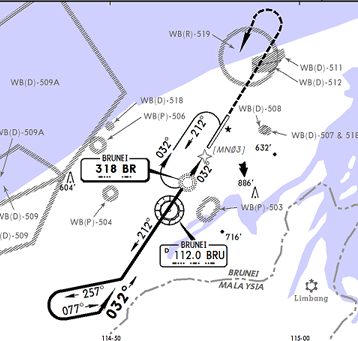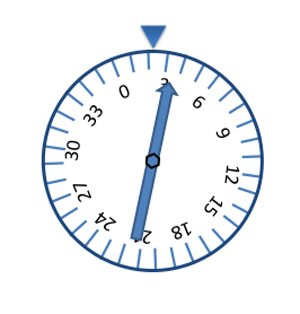We used to fly these routinely down in the crummiest weather just hoping the needle wasn't going to be 40° off, because it would do that on its own, or that someone on the ground wasn't doing something with a powerplant and would send the airplane into a mountain. (It would do that too, and it did that to a crew I knew.)
— James Albright

Updated:
2020-11-15
If you have to fly an NDB approach these days it probably means there isn't anything else left. In the United States you are now allowed to use GPS, provided the NDB is operational and monitored. (See New Overlay Procedures, below.) Overseas, many countries will allow you to use GPS instead. If the approach is valid under WGS-84 and the practice is allowed by the State pages, that's what I would do.
Flying an NDB without a computer's help is a lost art. Well, not exactly lost. Read on . . .

1
General description
The nondirectional beacon (NDB) is a ground-based radio transmitter that transmits radio energy in all directions. The ADF, when used with an NDB, determines the bearing from the aircraft to the transmitting station. The indicator may be mounted in a separate instrument in the aircraft panel. The ADF needle points to the NDB ground station to determine the relative bearing (RB) to the transmitting station. Magnetic heading (MH) plus RB equals the magnetic bearing (MB) to the station.
Source: Instrument Flying Handbook, page 7-3
An NDB approach is based off a non-directional beacon which is subject to environmental interference which often makes it unreliable. It is being phased out of use in much of the world and should always be your last choice in approach selection.
2
Equipment requirements
The airborne equipment includes two antennas, a receiver, and the indicator instrument. The “sense” antenna (nondirectional) receives signals with nearly equal efficiency from all directions. The “loop” antenna receives signals better from two directions (bidirectional). When the loop and sense antenna inputs are processed together in the ADF radio, the result is the ability to receive a radio signal well in all directions but one, thus resolving all directional ambiguity.
Source: Instrument Flying Handbook, page 7-3
3
Regulatory requirements
An instrument rating is needed, but the FAA is rapidly loosing interest in the entire concept of the NDB approach.
"The long-term plan includes the gradual phase out of NDB facilities, and at some point in time, the NDB approach will become nonexistent."
Source: FAA-H-8261-1, pg 5-57
4
Technique
The key to understanding the NDB approach is knowing that needle does one thing and one thing only: point to the beacon. You need to keep in your head the correct bearing to the station, the wind direction, and a suitable drift correction which you need to correct as the approach progresses. The following example is to Bandar Seri Begawan, Brunei. As an Air Force pilot we didn't have NDB receivers installed in the T-37, T-38, or KC-135 and I never saw an NDB approach until I was in the Boeing 707. This was my first:
- Fly the course reversal using ICAO procedures. Try to figure out the drift on your outbound leg, in our example lets say it took 10° of drift correction to the north to stay on course.
- Turning inbound, try to rollout on a heading equal to the course plus or minus the drift, 022° in our example.
- If, when you roll out, the needle is not pointing at your desired course, you need to correct. Let's say it is pointing at 027° instead of 032°, you want the needle to fall 5°. Turning left a few degrees will help that as will the wind. Once the needle is approaching 032° you need to remove the correction and turn back to 022°.
- If, when you roll out, the needle is on the other side, let's say 010°, you are on the wrong side of the needle. Remember from Course Intercepts, "the head always falls." So you need to turn left further than 010° to allow it to fall to the correct course.
- If, when you roll out, the needle is beyond the course, say 040°, you are left of course going further left. The needle cannot fall to 032° so you are going to have to turn right beyond 040°.
- Once you get the needle back where it belongs, on the 032° course, you watch its progress and make small corrections. Just like when flying a PAR approach, you fly precise headings and give yourself drift corrections as the approach progresses.
More about: Course Reversal.
5
Advantages
You will find these approaches at a lot of airports around the world where there is nothing else available.
6
Disadvantages
Radio beacons are subject to disturbances that may result in erroneous bearing information. Such disturbances result from such factors as lightning, precipitation static, etc. At night, radio beacons are vulnerable to interference from distant stations. Nearly all disturbances which affect the Automatic Direction Finder (ADF) bearing also affect the facility’s identification. Noisy identification usually occurs when the ADF needle is erratic. Voice, music or erroneous identification may be heard when a steady false bearing is being displayed. Since ADF receivers do not have a “flag” to warn the pilot when erroneous bearing information is being displayed, the pilot should continuously monitor the NDB’s identification.
Source: Aeronautical Information Manual ¶1-1-1 d.
Your altimeter is critical on these types of non-precision approaches and having the wrong QNH set can easily lead to a Controlled Flight Into Terrain (CFIT), as many accidents over the years prove. It is a good technique to verify the correct QNH with tower once you are handed over. Another common mistake is to think of your radio altitude (AGL) when targeting your MDA which should be a barometric altitude (MSL). Asking for the QNH will serve as a reminder where your focus needs to be.
I once flew an Air Force mission that required a lot of NDB approaches into some of the worst Eastern Europe had to offer. Most of these were decaying Soviet Union military fields where it was the NDB approach or nothing. You may have heard rumors that an ADF needle can indicate 40° in error for no reason at all. That's true. (We had INS to back the thing up.) . The ADF needle can be fooled by power lines. That's true too. (Six of my squadron mates didn't survive flying into such an approach in Croatia.) The NDB is a dying breed and I say good riddance. But it isn't gone yet. Be careful.
7
New overlay procedures
a. 1−2−3. Use of Suitable Area Navigation (RNAV) Systems on Conventional Procedures and Routes
Source: AIM 26 May 2016, Explanation of Changes.
This change allows for the use of a suitable RNAV system as a means to navigate on the final approach segment of an instrument approach procedure (IAP) based on a VOR, TACAN, or NDB signal. The underlying NAVAID must be operational and monitored for the final segment course alignment.
Uses of Suitable RNAV Systems. Subject to the operating requirements, operators may use a suitable RNAV system in the following ways.
Source: AIM 26 May 2016, ¶1-2-3.c.
- Determine aircraft position relative to, or distance from a VOR (see NOTE 5 below), TACAN, NDB, compass locator, DME fix; or a named fix defined by a VOR radial, TACAN course, NDB bearing, or compass locator bearing intersecting a VOR or localizer course.
- Navigate to or from a VOR, TACAN, NDB, or compass locator.
- Hold over a VOR, TACAN, NDB, compass locator, or DME fix.
- Fly an arc based upon DME.
- The allowances described in this section apply even when a facility is identified as required on a procedure (for example, “Note ADF required”).
- These operations do not include lateral navigation on localizer−based courses (including localizer back−course guidance) without reference to raw localizer data.
- Unless otherwise specified, a suitable RNAV system cannot be used for navigation on procedures that are identified as not authorized (“NA”) without exception by a NOTAM. For example, an operator may not use a RNAV system to navigate on a procedure affected by an expired or unsatisfactory flight inspection, or a procedure that is based upon a recently decommissioned NAVAID.
- Pilots may not substitute for the NAVAID (for example, a VOR or NDB) providing lateral guidance for the final approach segment. This restriction does not refer to instrument approach procedures with “or GPS” in the title when using GPS or WAAS. These allowances do not apply to procedures that are identified as not authorized (NA) without exception by a NOTAM, as other conditions may still exist and result in a procedure not being available. For example, these allowances do not apply to a procedure associated with an expired or unsatisfactory flight inspection, or is based upon a recently decommissioned NAVAID.
- Use of a suitable RNAV system as a means to navigate on the final approach segment of an instrument approach procedure based on a VOR, TACAN or NDB signal, is allowable. The underlying NAVAID must be operational and the NAVAID monitored for final segment course alignment.
- For the purpose of paragraph c, “VOR” includes VOR, VOR/DME, and VORTAC facilities and “compass locator” includes locator outer marker and locator middle marker.
NOTE—
References
(Source material)
Aeronautical Information Manual
FAA-H-8083-15, Instrument Flying Handbook, U.S. Department of Transportation, Flight Standards Service, 2001.
FAA-H-8261-1, Instrument Procedures Handbook, U.S. Department of Transportation, Flight Standards Branch, 2004

